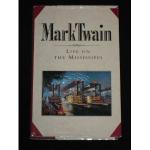Chapter 12 Sounding
When the river is very low, and one’s steamboat is ’drawing all the water’ there is in the channel,—or a few inches more, as was often the case in the old times,—one must be painfully circumspect in his piloting. We used to have to ‘sound’ a number of particularly bad places almost every trip when the river was at a very low stage.
Sounding is done in this way. The boat ties up at the shore, just above the shoal crossing; the pilot not on watch takes his ‘cub’ or steersman and a picked crew of men (sometimes an officer also), and goes out in the yawl—provided the boat has not that rare and sumptuous luxury, a regularly-devised ’sounding-boat’—and proceeds to hunt for the best water, the pilot on duty watching his movements through a spy-glass, meantime, and in some instances assisting by signals of the boat’s whistle, signifying ‘try higher up’ or ‘try lower down;’ for the surface of the water, like an oil-painting, is more expressive and intelligible when inspected from a little distance than very close at hand. The whistle signals are seldom necessary, however; never, perhaps, except when the wind confuses the significant ripples upon the water’s surface. When the yawl has reached the shoal place, the speed is slackened, the pilot begins to sound the depth with a pole ten or twelve feet long, and the steersman at the tiller obeys the order to ’hold her up to starboard;’ or, ’let her fall off to larboard;’{footnote [The term ‘larboard’ is never used at sea now, to signify the left hand; but was always used on the river in my time]} or ‘steady—steady as you go.’
When the measurements indicate that the yawl is approaching the shoalest part of the reef, the command is given to ‘ease all!’ Then the men stop rowing and the yawl drifts with the current. The next order is, ’Stand by with the buoy!’ The moment the shallowest point is reached, the pilot delivers the order, ‘Let go the buoy!’ and over she goes. If the pilot is not satisfied, he sounds the place again; if he finds better water higher up or lower down, he removes the buoy to that place. Being finally satisfied, he gives the order, and all the men stand their oars straight up in the air, in line; a blast from the boat’s whistle indicates that the signal has been seen; then the men ‘give way’ on their oars and lay the yawl alongside the buoy; the steamer comes creeping carefully down, is pointed straight at the buoy, husbands her power for the coming struggle, and presently, at the critical moment, turns on all her steam and goes grinding and wallowing over the buoy and the sand, and gains the deep water beyond. Or maybe she doesn’t; maybe she ‘strikes and swings.’ Then she has to while away several hours (or days) sparring herself off.
Sometimes a buoy is not laid at all, but the yawl goes ahead, hunting the best water, and the steamer follows along in its wake. Often there is a deal of fun and excitement about sounding, especially if it is a glorious summer day, or a blustering night. But in winter the cold and the peril take most of the fun out of it.




